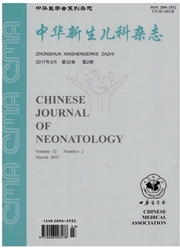

 中文摘要:
中文摘要:
目的 探讨晚期早产儿外周血淋巴细胞亚群和体液免疫指标的特点。方法 选择2012年6月至2013年6月在我院产科出生并除外窒息、感染、免疫缺陷等疾病的晚期早产儿(胎龄34~36周)为观察组,选择同期的早期早产儿(胎龄〈34周)和足月儿(胎龄37~42周)为对照组。所有新生儿均于生后24 h内检测外周血T淋巴细胞亚群分布情况及体液免疫水平。结果符合纳入标准的新生儿共203例,早期早产儿组、晚期早产儿组和足月儿组分别为57例、58例和88例。早期早产儿和晚期早产儿生后24 h内外周血CD3+、CD4+、CD8+及CD4+/CD8+均低于足月儿[CD3+:(47.3%±6.9%)、(60.6%±7.7%)比(73.8%±8.4%),CD4+:(27.1%±5.5%)、(37.1%±9.1%)比(50.8%±6.1%),CD8+:(14.9%±5.7%)、(17.9%±4.4%)比(21.4%±3.8%),CD4+/CD8+:(1.8±0.5)、(2.1±0.3)比(2.5±0.7),P〈0.05],晚期早产儿高于早期早产儿(P〈0.05)。早期早产儿和晚期早产儿IgG、IgM均低于足月儿[IgG:(5.33±3.05)、(8.81±2.97)比(12.65±2.21),IgM:(0.23±0.07)、(0.31±0.14)比(0.45±0.12),P〈0.05],晚期早产儿高于早期早产儿(P〈0.05);各组IgA水平差异无统计学意义(P〉0.05)。结论 晚期早产儿的T淋巴细胞亚群水平和体液免疫功能较早期早产儿有所提高,但仍低于健康足月儿,临床工作中应重视对晚期早产儿的护理和预防感染。
 英文摘要:
英文摘要:
Objective To investigate the characteristics of peripheral lymphocyte subsets and humoral immunity of late preterm infants. Methods Neonates admitted to our hospital from June 2012 to June 2013 were assigned to three groups: early preterm group [ gestational age (GA) 〈 34 w], late preterm group ( GA :34 - 36 w) and term infant group ( GA :37 - 42 w). Infants with asphyxia, infection or immunodeficiency disease were excluded. Peripheral blood were collected during the first 24 hours after birth. Lymphocyte subsets ( CD3 + , CD4 + , CD8 + , CD4+/CD8 ) and humoral immunity ( IgM, IgG, IgA) were analyzed by flow cytometry. Results A total of 203 infants were included: 57 cases in early preterm group, 58 cases in late preterm group and 88 cases in term infant group. The CD3+ , CD4+ , CD8+ and CD4+/CD8+ of both early preterm infants and late preterm infants were lower than term infants [(47.3% ±6.9%),(60.6% ±7.7%) vs. (73.8%±8.4%),(27.1% ±5.5%),(37.1% ± 9.1%) vs. (50.8% ±6. 1%),(14.9% ±5.7%),(17.9%±4.4%) vs. (21.4% ±3.8%),(1.8± O. 5). (2. 1 ±0. 3 ) vs. (2.5 ±O. 7 ). P 〈 O. 05 ]. and higher in late preterm infants than early oreterm infants (P 〈 0. 05 ). The IgG and IgM of both early preterm infants and late preterm infants were lower than term infants [ (5.33 ±3.05), (8.81 ±2. 97) vs. ( 12. 65±2. 21 ), (0. 23 ±0. 07), (0. 31±0. 14) vs. (0. 45±0. 12) ,P 〈0.05] ,and higher in late preterm infants than early preterm infants (P 〈0. 05). No statistical difference of IgA was found among the three groups ( P 〉 0. 05 ). Conclusions The peripheral lymphocyte subsets and humoral immunity of late preterm infants are better than early preterm infants,but the late preterm infants'immunity are still weaker than term infants. We should pay attention to late preterm infants in both nursing and infection prevention in clinical setting.
 同期刊论文项目
同期刊论文项目
 同项目期刊论文
同项目期刊论文
 期刊信息
期刊信息
